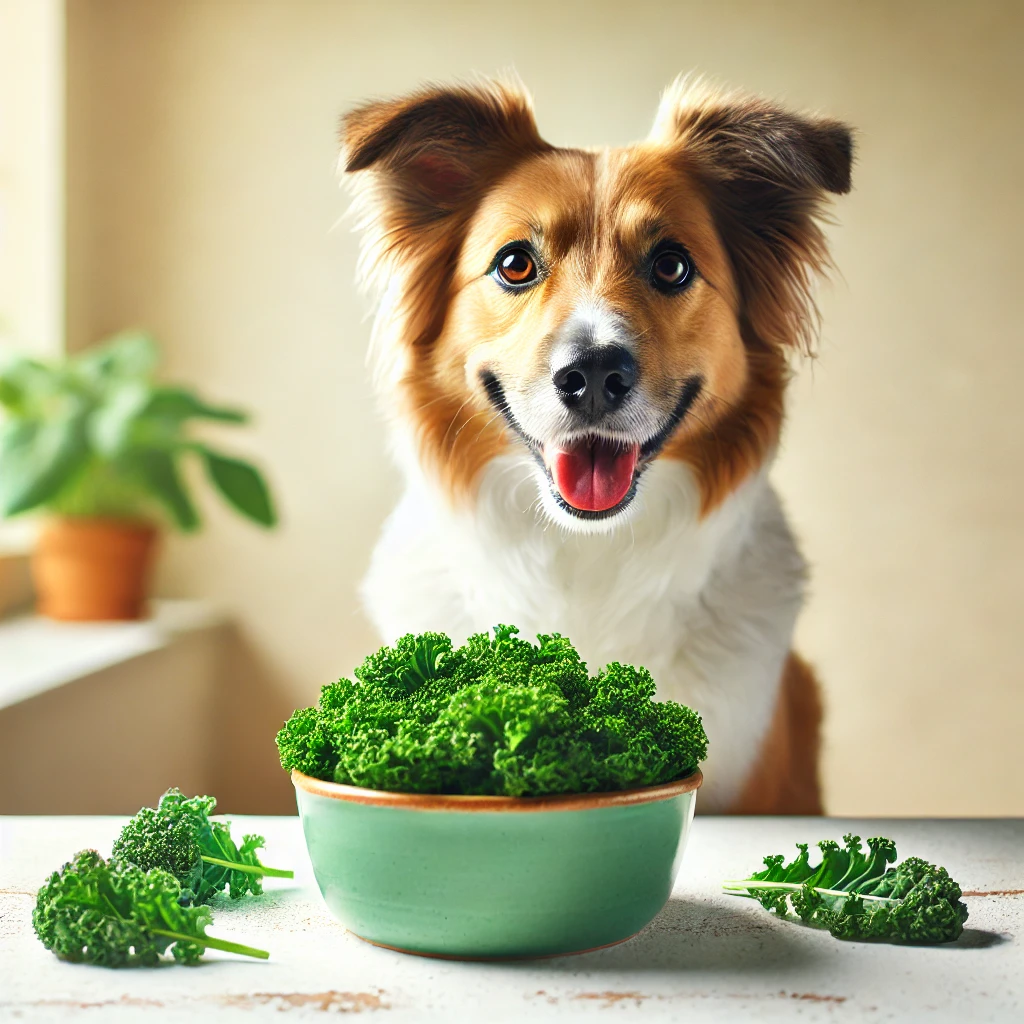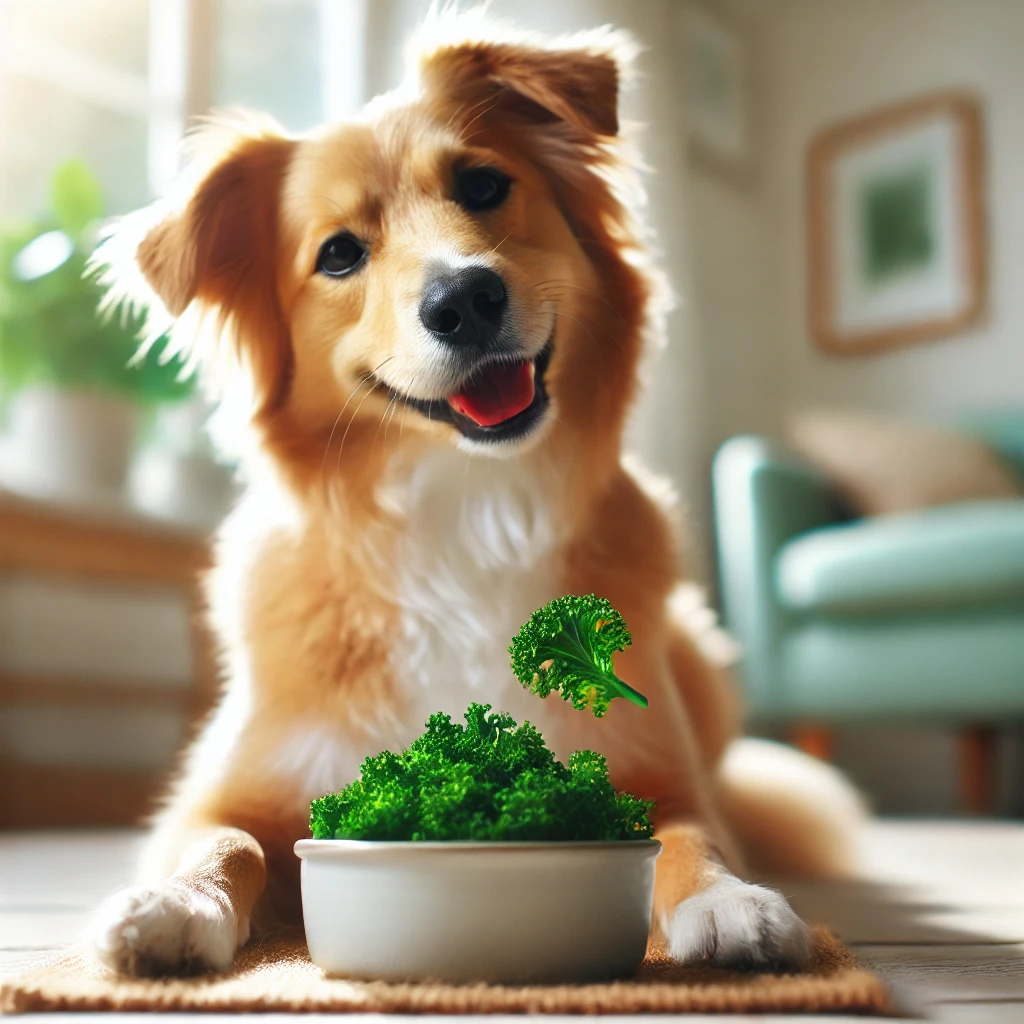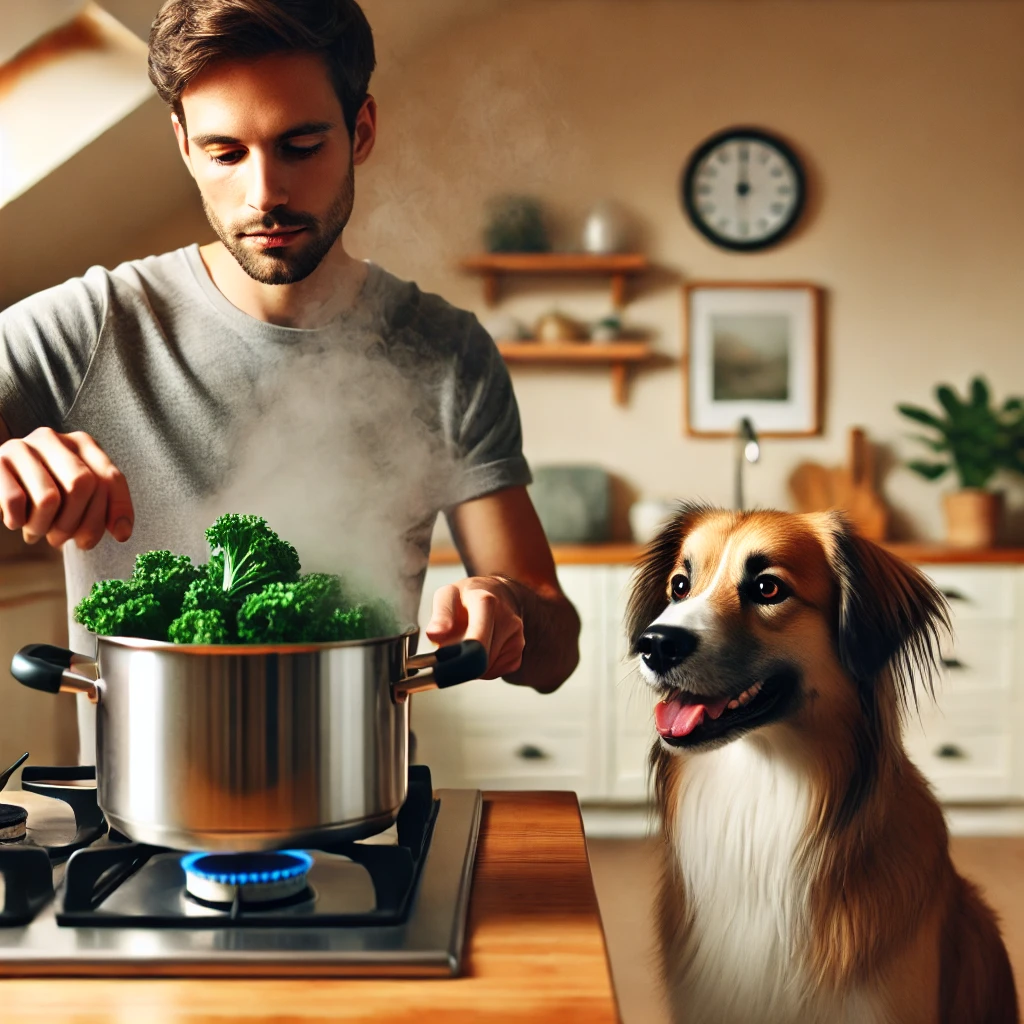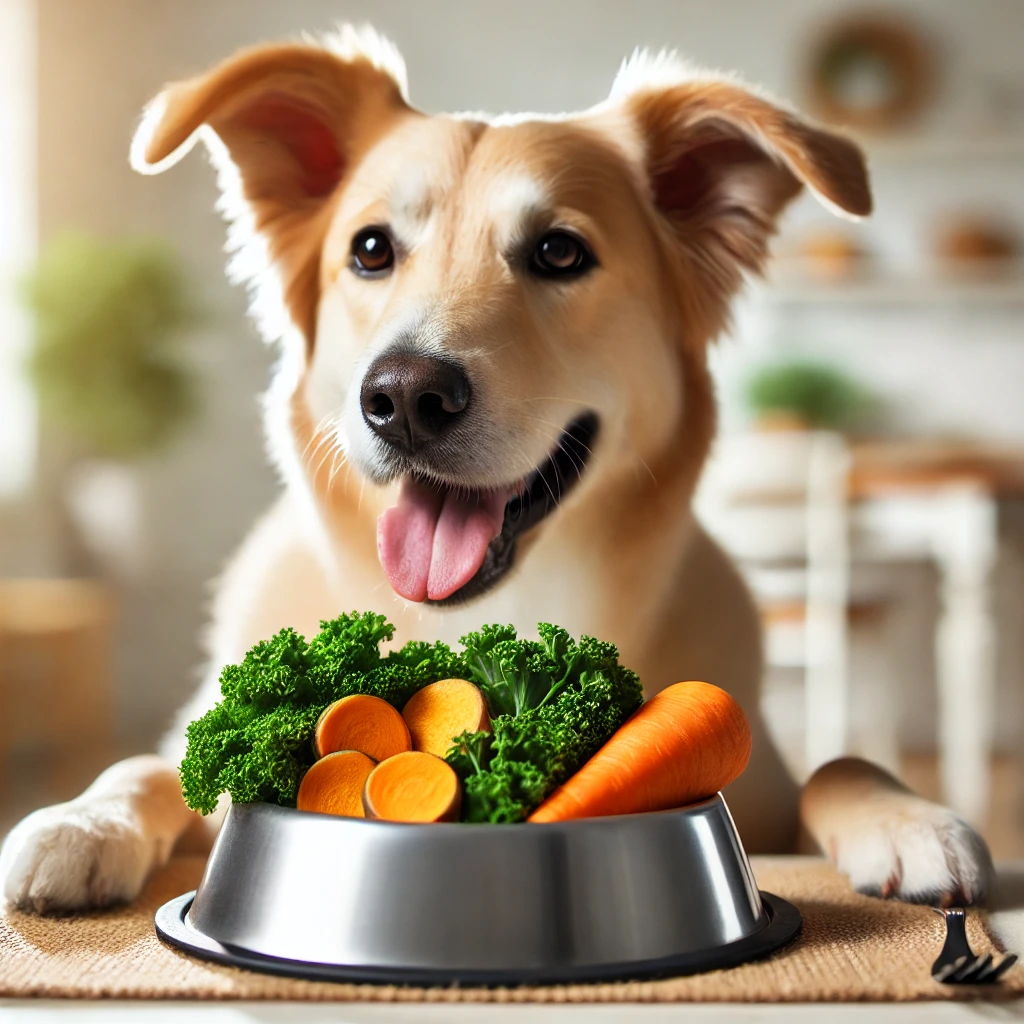
Kale has long been celebrated as a superfood for humans, loaded with vitamins and minerals that support a healthy lifestyle.
But what about our furry friends?
Can dogs eat kale every day and reap the same health benefits, or are there risks involved?
In this post, we’ll dive into what veterinarians have to say about feeding kale to dogs on a daily basis.
We’ll also discuss the nutritional benefits and potential dangers of this leafy green, ensuring that you’re fully informed about whether kale is a safe option for your dog.
Nutritional Benefits of Kale for Dogs

Kale is often called a powerhouse of nutrients, and for good reason!
Here’s a breakdown of the nutrients found in kale and how they can benefit your dog:
- Vitamins A, C, and K: These vitamins support healthy vision, boost the immune system, and promote strong bones. Vitamin K, in particular, is essential for blood clotting.
- Fiber: Kale is packed with fiber, which can aid in digestion and help regulate your dog’s bowel movements.
- Antioxidants: Kale is rich in antioxidants, which fight off free radicals that can lead to chronic diseases, including cancer.
- Calcium: This mineral helps maintain bone strength and supports overall skeletal health.
With all these health-boosting nutrients, it might seem like kale is the perfect daily addition to your dog’s diet. But there’s more to consider.
Potential Risks of Feeding Kale Daily
While kale is often praised as a nutritional powerhouse, it’s important to recognize that certain compounds in kale can pose risks to dogs if consumed in excessive amounts or on a daily basis.
Understanding these risks can help you make an informed decision about how often to include kale in your dog’s diet.
Here are the potential dangers of feeding kale every day:
1. Oxalates and the Risk of Kidney Stones
Kale is rich in oxalates, naturally occurring compounds that can bind to calcium in the body and form insoluble crystals.
While a small amount of oxalates is typically harmless, when consumed regularly in large quantities, they can lead to health issues in some dogs.
The primary concern is the development of kidney stones or bladder stones.
- Kidney Stones: Dogs that are prone to urinary tract issues or that have a history of kidney problems may be at a higher risk of developing kidney stones if they consume kale frequently. These stones form when oxalates build up and crystallize in the urinary tract. Over time, this can cause pain, discomfort, difficulty urinating, and even more serious complications if left untreated.
- Bladder Stones: Similar to kidney stones, oxalates can also contribute to bladder stone formation. Symptoms of bladder stones in dogs include frequent urination, blood in the urine, or straining to urinate. If you notice any of these signs in your dog, consult a vet immediately.
Veterinarians generally advise limiting the intake of oxalate-rich vegetables, like kale, for dogs with preexisting kidney or urinary conditions.
While occasional servings may be fine, feeding kale every day can increase the risk of stone formation.
2. Goitrogens and Thyroid Health
Another compound found in kale that can be problematic when consumed in excess is goitrogen.
Goitrogens are substances that can interfere with the normal function of the thyroid gland, which regulates your dog’s metabolism, energy levels, and overall hormonal balance.
- Thyroid Suppression: In dogs that are particularly sensitive to goitrogens, consuming kale on a regular basis may inhibit the thyroid’s ability to produce essential hormones, leading to hypothyroidism. This condition can cause a wide range of health issues, including weight gain, lethargy, hair loss, and cold intolerance.
- Goiter Development: Prolonged exposure to goitrogens can also lead to an enlarged thyroid gland, known as a goiter. This enlargement can cause visible swelling around the throat area and may lead to difficulty breathing or swallowing in severe cases.
While the amount of goitrogens in occasional servings of kale is unlikely to cause harm, daily consumption increases the risk of thyroid disruption, especially in dogs with a predisposition to thyroid conditions.
To prevent this, it’s best to offer kale in moderation and incorporate a variety of other vegetables in your dog’s diet.
3. Digestive Upset
Kale is high in fiber, which can benefit a dog’s digestive system when given in appropriate amounts.
However, too much fiber—especially if introduced too quickly or consumed daily—can lead to digestive distress in dogs.
- Bloating and Gas: Kale, like many cruciferous vegetables (such as broccoli and cabbage), can cause gas and bloating if fed in large quantities. Some dogs may be more sensitive to these effects, leading to discomfort and restlessness.
- Diarrhea: Excessive fiber intake can also cause diarrhea, particularly if a dog isn’t used to eating high-fiber foods. This is more likely to occur if the kale is served raw, as uncooked kale can be harder for dogs to digest.
- Stomach Upset: Kale contains naturally occurring compounds called isothiocyanates, which can be toxic to dogs in very large amounts. While it’s rare for dogs to eat enough kale to experience toxicity, daily consumption over time could increase the risk of stomach upset, nausea, or more serious digestive problems.
To minimize these risks, it’s essential to introduce kale gradually into your dog’s diet, monitor their digestive response, and avoid feeding it too frequently.
Lightly cooking or steaming kale can also help make it easier for dogs to digest and reduce the risk of gastrointestinal discomfort.
4. Imbalance in Nutritional Variety
While kale is nutritious, relying too heavily on it in your dog’s diet can lead to nutritional imbalances.
Dogs require a well-rounded diet that includes a variety of proteins, carbohydrates, fats, vitamins, and minerals.
Feeding kale every day could displace other important nutrients from their meals, leading to deficiencies over time.
- Variety is Key: Just like with humans, dogs benefit from variety in their diet. Over-reliance on one type of food, even one as healthy as kale, can prevent dogs from getting the full spectrum of nutrients they need to stay healthy. For example, while kale is rich in certain vitamins like A and K, it may lack other essential nutrients like vitamin E or omega-3 fatty acids that your dog requires for optimal health.
Ensuring your dog’s diet includes a variety of vegetables, lean proteins, and other nutrient-dense foods is the best way to promote long-term health.
In summary, while kale can be a healthy addition to your dog’s diet, feeding it every day may lead to problems like kidney stones, thyroid suppression, digestive upset, and nutritional imbalances.
Moderation is crucial. As always, consult with your vet before introducing new foods into your dog’s diet, particularly if your dog has pre-existing health conditions.
A diverse and balanced diet is key to keeping your dog happy, healthy, and thriving!
What Vets Recommend

Most veterinarians agree that while kale can be a healthy, occasional treat, it should not be fed to dogs every day.
Here’s what vets recommend when it comes to kale:
- Moderation is Key: According to Dr. Amanda Nascimento, DVM, dogs should not consume kale daily due to its oxalate and goitrogen content. Vets generally suggest offering kale a couple of times per week rather than daily to avoid overloading your dog’s system.
- Portion Control: A small amount of kale—no more than a few leaves per serving—should be enough to provide your dog with its nutritional benefits without posing risks. Larger portions can increase the risk of oxalate accumulation or thyroid suppression.
- Balanced Diet: Dogs need a varied and balanced diet to thrive, and while kale has benefits, it shouldn’t be the only vegetable they consume. Rotating kale with other safe veggies will ensure that your dog gets a variety of nutrients without overexposure to any harmful compounds.
How to Safely Serve Kale to Your Dog

If you decide to offer kale to your dog occasionally, here are some tips on how to prepare it safely:
- Steamed, Not Raw: Lightly steam kale before giving it to your dog. This helps reduce the oxalate content and makes it easier for your dog to digest.
- Chop It Up: Cut the kale into small pieces to prevent choking, especially for smaller dogs.
- Avoid Seasoning: Dogs should eat plain kale, free from any added oils, butter, salt, or seasoning, which can upset their stomach or contribute to obesity.
- Mix with Other Veggies: To maintain variety in your dog’s diet, mix kale with other dog-safe vegetables like carrots, green beans, or sweet potatoes.
Alternatives to Feeding Kale Every Day

While kale offers a variety of health benefits, it’s important to maintain diversity in your dog’s diet to prevent overexposure to certain compounds and ensure they receive a well-rounded mix of nutrients.
Fortunately, there are many other healthy vegetables and foods that are safe for dogs and can provide similar nutritional benefits.
By rotating different veggies into your dog’s meals, you can avoid the potential risks of feeding kale every day while still offering variety and essential nutrients.
Here are some excellent alternatives:
1. Green Beans
Green beans are a fantastic low-calorie vegetable that can be a regular part of your dog’s diet.
They are rich in fiber, which supports healthy digestion, and contain vitamins such as A, C, and K.
- Nutritional Benefits: Green beans provide a good source of fiber to keep your dog’s digestive system running smoothly, along with antioxidants that support immune function. They’re also low in calories, making them an excellent choice for weight management.
- How to Serve: Serve them cooked and plain, either steamed or boiled, without added salt, butter, or seasoning. You can mix green beans with your dog’s regular food or offer them as a healthy snack on their own.
2. Carrots
Carrots are another nutrient-rich vegetable that dogs tend to love.
They are packed with beta-carotene, which is converted into vitamin A in the body, supporting healthy vision, immune function, and skin.
- Nutritional Benefits: Carrots are high in vitamins and antioxidants, which help maintain your dog’s overall health. They are particularly beneficial for eye health and can contribute to a shinier coat.
- How to Serve: Carrots can be served raw as a crunchy treat or steamed for easier digestion. Some dogs may prefer the texture of cooked carrots, but both options are safe and healthy. They also make for a great alternative to traditional treats when training or rewarding your dog.
3. Spinach
Spinach, like kale, is another leafy green vegetable that provides valuable nutrients, but it should also be fed in moderation due to its high oxalate content.
Spinach contains vitamins A, C, and K, as well as iron and fiber.
- Nutritional Benefits: Spinach supports bone health, boosts immunity, and aids digestion. It’s also rich in antioxidants, helping to protect against cellular damage.
- How to Serve: Lightly steam spinach to reduce its oxalate content and make it easier for your dog to digest. Avoid serving spinach raw or in large quantities, especially if your dog is prone to kidney or bladder issues. Rotate spinach with other vegetables to ensure balance.

4. Broccoli
Broccoli is another cruciferous vegetable like kale, but it is lower in oxalates, making it a safer option for frequent feeding.
It’s rich in fiber, vitamins C and K, and antioxidants.
- Nutritional Benefits: Broccoli supports a healthy immune system, promotes digestive health, and has anti-inflammatory properties. The fiber content helps regulate bowel movements, while the antioxidants help reduce the risk of chronic diseases.
- How to Serve: Cook broccoli by steaming or boiling it until tender, and serve it in small amounts. Avoid overfeeding, as too much broccoli can cause gas and digestive upset due to its fiber content. Mixing small pieces of broccoli into your dog’s food can be a great way to provide variety.
5. Sweet Potatoes
Sweet potatoes are an excellent source of complex carbohydrates, fiber, and important vitamins like A and C.
They are low in fat and rich in nutrients that support overall health, especially in dogs with sensitive stomachs.
- Nutritional Benefits: Sweet potatoes are loaded with beta-carotene, which is converted to vitamin A and helps improve vision, skin, and coat health. They also support digestive health with their high fiber content.
- How to Serve: Serve cooked sweet potatoes—baked, boiled, or steamed—without any seasonings or additives. You can mash them or cut them into small cubes and mix them into your dog’s regular food for a nutritious boost.
6. Zucchini
Zucchini is a low-calorie vegetable that’s packed with vitamins and minerals, making it a great addition to your dog’s meals.
It contains vitamin C, potassium, and magnesium, all of which are important for your dog’s overall health.
- Nutritional Benefits: Zucchini promotes hydration due to its high water content and supports muscle and nerve function with its potassium and magnesium content. It’s also gentle on the digestive system, making it suitable for dogs with sensitive stomachs.
- How to Serve: Zucchini can be served raw or cooked. You can chop it into small pieces and add it to your dog’s food, or serve it as a snack. If serving cooked, steaming or lightly boiling is best to retain its nutrients.
7. Peas
Peas are another nutrient-dense vegetable that is safe for dogs and can be rotated with kale.
They are rich in protein, fiber, and several important vitamins like B6, C, and K.
- Nutritional Benefits: Peas support muscle health with their protein content and aid in digestion with their fiber. They also promote heart health due to their antioxidant properties.
- How to Serve: Peas can be served cooked or raw, though it’s best to avoid canned peas, which often contain added sodium. You can mix peas into your dog’s food or offer them as an occasional treat.
8. Pumpkin
Pumpkin is a well-known digestive aid for dogs and is rich in fiber, beta-carotene, and vitamins.
It’s particularly useful for dogs with sensitive stomachs or irregular bowel movements.
- Nutritional Benefits: Pumpkin supports digestive health, regulates bowel movements, and contains antioxidants that promote immune function. It’s also a low-calorie option that can be easily incorporated into your dog’s diet.
- How to Serve: Serve plain, canned pumpkin (without any added sugar or spices) or cook fresh pumpkin. A small spoonful added to your dog’s regular food can help with digestion and provide a nutritional boost.
9. Bell Peppers
Bell peppers, especially red ones, are packed with vitamins A and C, as well as antioxidants.
They make for a colorful and nutrient-rich addition to your dog’s diet.
- Nutritional Benefits: Bell peppers help support the immune system, improve eye health, and promote a shiny coat. The high antioxidant content also helps fight inflammation.
- How to Serve: Bell peppers can be served raw or lightly cooked. Make sure to remove the seeds and core, and cut the peppers into small, bite-sized pieces to prevent choking.
10. Cucumber
Cucumbers are another low-calorie, hydrating vegetable that dogs can enjoy.
They are particularly useful as a refreshing snack, especially during the warmer months.
- Nutritional Benefits: Cucumbers are mostly water, so they are great for keeping your dog hydrated. They also contain vitamins K and C, which support bone health and boost immunity.
- How to Serve: Serve cucumber raw, cut into small pieces, and without the skin if your dog has a sensitive stomach. It can be added to their meals or offered as a crunchy, low-calorie snack.
Rotating Vegetables for a Balanced Diet
The key to maintaining a healthy, well-rounded diet for your dog is variety.
Rather than feeding kale or any single vegetable daily, rotate different veggies throughout the week.
This ensures that your dog gets a wide range of nutrients without overloading on any one compound.
For example:
- Monday: Carrots and broccoli
- Wednesday: Green beans and sweet potatoes
- Friday: Pumpkin and zucchini
- Sunday: A small portion of kale, peas, and bell peppers
By incorporating a range of dog-safe vegetables, you can provide your dog with essential vitamins, minerals, and fiber, while reducing the risk of any negative effects from overconsumption of any one vegetable, such as kale.
A Balanced Approach to Feeding Vegetables
While kale has its benefits, feeding it to your dog every day is unnecessary and may pose risks over time.
Instead, incorporate a variety of vegetables into your dog’s diet to ensure they receive all the essential nutrients they need without the potential downsides of consuming kale too frequently.
Always introduce new vegetables gradually and consult with your veterinarian if you have concerns about your dog’s diet.
By rotating these healthy vegetable alternatives, you’ll keep your dog happy, healthy, and enjoying the benefits of a diverse diet! with eating kale daily.
Conclusion

So, can dogs eat kale every day?
The answer is that while kale offers numerous health benefits, it should not be a daily part of your dog’s diet. Veterinarians recommend moderation, suggesting that kale be fed no more than a couple of times per week.
The risks associated with overfeeding kale—like kidney stones or thyroid issues—make it essential to balance it with other vegetables.
Always consult your vet before adding new foods to your dog’s diet, especially if your pet has existing health concerns.
With a bit of care and variety, your dog can enjoy the occasional leafy green snack without any problems!
FAQs

1. Can puppies eat kale?
Yes, but in moderation and only when introduced gradually into their diet.
Always consult your vet before giving kale to puppies, as their digestive systems are more sensitive.
2. Can dogs eat raw kale?
It’s better to serve kale lightly steamed, as raw kale can be harder for dogs to digest and may lead to stomach upset.
3. Are there dogs who should avoid kale entirely?
Dogs with a history of kidney stones or thyroid problems should avoid kale due to its oxalate and goitrogen content.
Consult your vet for personalized advice.
4. How much kale is safe for my dog to eat?
A few leaves of kale once or twice a week is considered safe for most dogs.
Avoid large portions to minimize the risk of health issues.
By following these guidelines, you can provide your dog with a balanced, healthy diet while ensuring they enjoy the benefits of kale without the associated risks.
If you found this post helpful, be sure to share it with other dog lovers!

